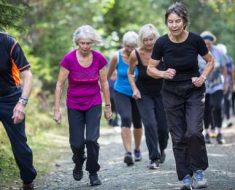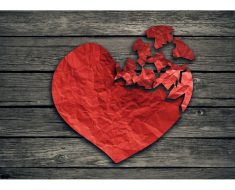Almost daily we are exposed to images of disastrous droughts, hurricanes and wildfires. We’re presented with dizzying facts and figures about “climate crisis,” greenhouse emissions, and the importance of holding global warming at 1.5 degrees. Not to mention we’re seeing multiple species of animals dying out, the oceans being over-polluted, and, oh yes, we are using far too much plastic. If you find the recent headlines of the state of our planet can feel overwhelming, almost paralyzing, at times, you’re not alone. People are panicking about the state of our planet — and it’s leading to some all too consuming, existential dread.
Many of us are now experiencing a condition called “eco anxiety” and its effects are very real. A 2017 report released by the American Psychological Association (APA) found that climate change can take a significant toll on mental health, including inducing trauma-like symptoms and defines eco-anxiety as “a chronic fear of environmental doom.”
When you’re casually consumed by grief and worry about the planet.
So how do you know if you’re experiencing eco-anxiety? Dr. Erica Dodds, COO of the Foundation for Climate Restoration, tells SheKnows that eco-anxiety is “the feeling that everything we do is somehow damaging the planet, and indirectly damaging us.”
According to Dodds, people who experience eco-anxiety run from two extremes. On one hand, they may be more proactive than most in taking measures to protect resources, like using reusable water bottles and food storage containers, and reducing single-use plastic consumption. Or, on the other hand, “they may feel so powerless to stop the degradation of the environment that they can’t handle thinking about it at all,” she says. “They may avoid taking proactive steps because it seems to make so little difference and forces them to confront the incredible scale of the problem.”
Eco-anxiety has increased over the years. Dr. Kriss A. Kevorkian is no stranger to the mental anguish caused by the global crisis. Back in 2004, she coined the term “environmental grief,” which she defines as “the grief reaction stemming from the environmental loss of ecosystems caused by natural or man-made events.” While environmental grief is not a mental health disorder and differs from eco-anxiety, Kevorkian says her experience with researching the phenomenon, which started in 2001, has proven that our concern with our planet, both mentally and emotionally, has only increased.
“When I first conducted research on environmental grief in 2001, I was told I was the only person researching it,” she tells SheKnows. “In 2006, I presented my research at two conferences at Oxford University. Some participants said that I put a name to a feeling they had but didn’t know what that feeling was. Other participants questioned, ‘Why would anyone grieve over the loss of the environment?’”
Today, Kevorkian says she runs into “a lot of people” who are experiencing environmental grief and eco-anxiety.
How to deal with it.
Like most things, social media and media attention, are triggering our helplessness when it comes to the planet. “These days, we’re confronted by poignant images and facts almost constantly,” says Dodds. “While there used to be more distance between any one person and the world, it now feels like every problem in the world is right in our living rooms with us.”
While different strategies will work for different people, both Dodds and Kevorkian believe that taking action is the best cure for alleviating your eco-anxiety. “When it comes to both environmental grief and eco-anxiety, I encourage people to sit for a moment and just in that one moment find something to be grateful for,” says Kevorkian. “If you’re able to see the beauty of Nature for one moment and appreciate her then do it! If not, then think about all those people who are working to save Nature.”

While Kevorkian admits there is an “overwhelming amount of horrible things happening in our world today” that requires time to process, she says it shouldn’t hold you back from doing your part. “It’s easy to stay in bed with the covers over our heads hoping someone else will do something, but it’s time for us to start putting Nature first and all that she needs because without her, we won’t exist.”
If taking action can seem overwhelming at times, Dodds says, “make peace with the fact that you can’t do everything. I find it helpful to network and see first-hand that other people are working on issues that I care deeply about but don’t have the time to contribute to.”
Dodds says there are many approaches to decreasing one’s own carbon footprint, including choosing to bike rather than driving, opting for sustainable eco-friendly products, eating less meat, or having fewer children, but ultimately “the problem is beyond the scale of individual actions.” She suggests joining or supporting groups who are actively working on a global level, including the Foundation for Climate Restoration, Extinction Rebellion, Sunrise Movement, Citizens Climate Lobby, and others. Kevorkian says her own research with environmental grief spurred her to take action locally to get Rights of Nature for the Southern Resident Orcas and founded the group, Legal Rights for the Salish Sea. Making small recurring donations to organizations working in areas you care about, or subscribing to their newsletters to keep yourself engaged with their causes is another easy way to do your part, says Dodds. Plus, it can be deeply beneficial to find ways to feel more hopeful and less helpless.
“With collective action, individuals can work together to drive the systemic change needed to address the roots of climate change and eco-anxiety,” she says.
But there’s still hope, right?
When it comes to solving the world’s plight, the reactions from our experts are mixed — but not without hope.
“I honestly don’t know the answer to that question, and it’s one I’m asked often,” says Kevorkian. “My response is that I’ve spent my life as an environmental activist. I don’t plan on stopping anytime soon. My hope would be that people become more conscious very quickly, like yesterday, and consider what they buy and how it will be disposed of when they no longer want it, how they eat, how they travel and which political leaders they support.”
For her part, Dodds is optimistic. “I believe strongly that we can save the planet,” she says. “In fact, I think we can restore the climate and ensure the survival of our species and most of those around us. It won’t be fast or easy. We need to be optimistic and ambitious, active and engaged. We need to demand things change e.g. by voting, putting pressure on local leaders, supporting green initiatives and championing environmental tech companies.”
“I’d very much like to see Nature have laws to protect her rather than laws that protect the corporations polluting and murdering ecosystems. Instead of thinking of property and land as something sustainable that we manage, let’s think about how we can best be caretakers for all who live here,” Kevorkian adds. “Corporations have rights but Nature doesn’t. Isn’t it time that Nature have a seat at the table given that everything we do impacts her health and therefore our health? Let’s make this huge paradigm shift to give Nature rights before we lose more trees, birds, insects and ecosystems that in the end keep us alive.”
Source: Read Full Article





